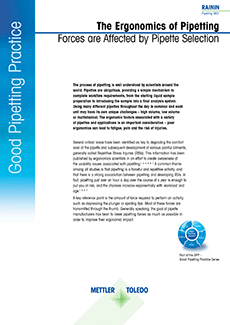 |
Greater mass per unit compared to water makes a dense liquid more subject to gravity. Air in a pipette during aspiration stretches to carry the extra weight per unit, so less dense liquid is aspirated per unit than water.
Liquids more dense than water, since they are heavier, exert a greater pull on the air inside regular air cushion pipettes during aspiration. This can lead to less than the expected volume being aspirated.
Liquids less dense than water pose the opposite challenge: an excessive volume may be aspirated because of the liquid's low density – its lightness relative to water.
A positive displacement pipette, with no air between the pipette piston and the liquid, is the right instrument to accurately pipette dense and low density liquids.
However, if the solution density is known and an analytical balance is available, you can use a traditional pipette to find out what volume adjustment is necessary to deliver an accurate volume. Here's how:
Hypothetical Example: Pipetting 10 µL of a 1.25 mg/µL liquid.
- Set the pipette volume to 10 µL.
- Aspirate the liquid and dispense it into the weighing dish of an analytical balance. In this hypothetical example, let's say the balance reading for the delivered liquid is not the expected 12.5 mg, but slightly less: 12.0 mg.
- How many µL were dispensed? Calculate 10 μL x (12.0 [actual] /12.5 [expected] ) = 9.6 μL.
- To adjust the volume setting to deliver an accurate 10 µL: Calculate 10 μL x (12.5 [expected] /12.0 [actual] ) = 10.42 μL.
To pipette an accurate and precise 10 µL of the hypothetical liquid in this example, set the pipette volume to 10.42 µL
Browse positive displacement pipette and pipette for more information.








